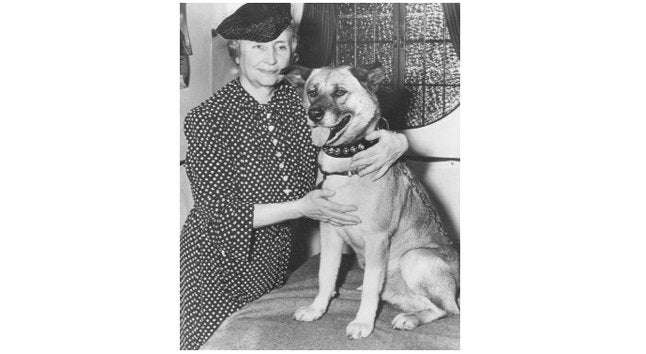When Keller visited Akita Prefecture in Japan in July 1937, she inquired about Hachikō, the famed Akita dog that had died in 1935. She told a Japanese person that she would like to have an Akita dog; one was given to her within a month, with the name of Kamikaze-go. When he died of canine distemper, his older brother, Kenzan-go, was presented to her as an official gift from the Japanese government in July 1938. Keller is credited with having introduced the Akita to the United States through these two dogs. By 1939 a breed standard had been established and dog shows had been held, but such activities stopped after World War II began. Keller wrote in the Akita Journal:
If ever there was an angel in fur, it was Kamikaze. I know I shall never feel quite the same tenderness for any other pet. The Akita dog has all the qualities that appeal to me – he is gentle, companionable and trusty.
Eventually, Hachikō's legendary faithfulness became a national symbol of loyalty, particularly to the person and institution of the Emperor.
Hachikō died on March 8, 1935, and was found on a street in Shibuya. In March 2011 scientists settled the cause of death of Hachikō: the dog had terminal cancer and a filaria infection (worms). There were also four yakitori skewers in Hachikō's stomach, but the skewers did not damage his stomach or cause his death.
Hachikō's stuffed and mounted remains are kept at the National Science Museum of Japan in Ueno, Tokyo. His monument is in Aoyama cemetery in Minatoku, Tokyo.
In April 1934, a bronze statue in his likeness was erected at Shibuya Station, and Hachikō himself was present at its unveiling. The statue was recycled for the war effort during World War II. In 1948 The Society for Recreating the Hachikō Statue commissioned -Takeshi Ando, son of the original artist, to make a second statue. When the new statue appeared, a dedication ceremony occurred. The new statue, which was erected in August 1948, still stands and is an extremely popular meeting spot. The station entrance near this statue is named "Hachikō-guchi", meaning "The Hachikō Entrance/Exit", and is one of Shibuya Station's five exits.
A similar statue stands in Hachikō's hometown, in front of Ōdate Station. In 2004, a new statue of Hachikō was erected on the original stone pedestal from Shibuya in front of the Akita Dog Museum in Odate.
The exact spot where Hachikō waited in the train station is permanently marked with bronze paw-prints and text in Japanese explaining his loyalty. Each year on April 8, Hachikō's devotion is honored with a solemn ceremony of remembrance at Tokyo's Shibuya railroad station. Hundreds of dog lovers often turn out to honor his memory and loyalty.

bryantmakesprog on January 19th, 2020 at 17:32 UTC »
Totally serious question: how was the name of the dog communicated to her?
Toothfood on January 19th, 2020 at 15:34 UTC »
TIL Japan is like the parents who try to replace their kid’s goldfish without them knowing.
goddamnzilla on January 19th, 2020 at 15:03 UTC »
Making her the first...
What about the one she was given? Wtf? This headline is beyond confusing...